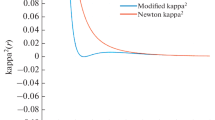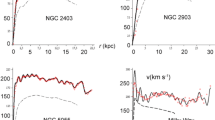A new, alternative approach is proposed to explain the flat velocity spectrum of orbital motion of stars at the periphery of spiral galaxies and, in particular, the significant excess of velocity values calculated according to the virial theorem. The concept consists in the assumption of the presence in the gravitational field of the galaxy of a central body of cylindrical rather than spherical symmetry. This configuration of the field can be explained by the presence along the galactic axis of a cosmic string, whose length overlaps the diameter of the galactic disk. This model will be subjected to comparison with the more traditional concept of the presence in a spiral galaxy of a spherical halo of dark matter. For this approach a kinematic model is also proposed and a hypothesis is enunciated regarding the nature of dark matter. Results of astronomical observations on the presence of cosmic strings in zones adjacent to galaxies are analyzed.
Similar content being viewed by others
References
Ya. B. Zel’dovich and I. D. Novikov, Relativistic Astronomy [in Russian], Nauka, Moscow (1967).
M. Rees, Ed., Universe, DK, London (2005).
M. V. Sazhin, Contemporary Cosmology in the Popular Presentation [in Russian], Editorial URSS, Moscow (2008).
L. Popov, The Astronomers have Caught the Galaxy of Dark Matter by the Tail [in Russian], Electronic publication: http://www.membrana.ru/ particle/914
A. D. Linde, Particle Physics and Inflationary Cosmology, CRC Press, Boca Raton, Florida (1990).
A. Vilenkin and E. P. Shellard, Cosmic Strings and Other Topological Defects, Cambridge University Press, Cambridge, UK (1994).
B. Greene, The Elegant Universe, W. W. Norton, New York (1999).
A. D. Chernin, Stars in Physics [in Russian], Editorial URSS, Moscow (2004).
E. V. Kononovich and V. I. Moroz, General Course of Astronomy [in Russian], Editorial URSS, Moscow (2004).
V. A. Rubikov, Dark Matter and Dark Energy in the Universe [in Russian], Electronic publication: http://victorpetrov.ru/temnaya-materiya-i-temnaya-energiya-vo-vse.html
Dark energy distribution map [in Russian], Electronic publication: http://world-phenomena.ru/166-kartatemnoy-storony.html
A. A. Smol’nikov, Priroda, No. 7, 10–19 (2001).
A. M. Cherepashchuk, Gravitational Microlensing and the Problem of Hidden Mass [in Russian], Electronic publication: http://www.astronet.ru/db/msg/1171344.
Joseph Silk, Baryonic dark matter, arXiv:astro-ph/9407024v1.
Author information
Authors and Affiliations
Corresponding author
Additional information
Translated from Izvestiya Vysshikh Uchebnykh Zavedenii, Fizika, No. 12, pp. 35–39, December, 2012.
Rights and permissions
About this article
Cite this article
Koganov, A.V., Krechet, V.G. New Approach to the Problem of Structure of Spiral Galaxies. Russ Phys J 55, 1410–1415 (2013). https://doi.org/10.1007/s11182-013-9974-y
Received:
Published:
Issue Date:
DOI: https://doi.org/10.1007/s11182-013-9974-y




